|
|
|
Sort Order |
|
|
|
Items / Page
|
|
|
|
|
|
|
| Srl | Item |
| 1 |
ID:
096844
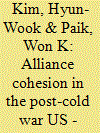

|
|
|
| 2 |
ID:
150938
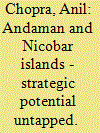

|
|
|
| 3 |
ID:
171246
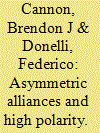

|
|
|
|
|
| Summary/Abstract |
The Middle East and the Horn of Africa exist in two distinct regional security complexes (RSCs), groupings of states exhibiting intense security interdependence within a distinct region, but rarely between regions. Recent geopolitical changes and related analyses, however, point to either a subsuming or a joining of the two RSCs, potentially leading to a high degree of uncertainty in two conflict-prone regions. Given the importance of such developments, we question this theory of RSC expansion by offering a concise review of recent security interactions between the two RSCs as well as quantitatively and qualitatively measuring the material power capabilities of relevant states. Borrowing from and contributing to RSC theory, we also identify and analyse concepts and indicators such as threat perception and sub-regional alliances. Our findings demonstrate the Middle East RSC is not expanding to include that of the Horn of Africa. The two remain distinct and under internal consolidation, despite the current discourse. Rather, high polarity in the Middle East coupled with often-congruent interests in Horn of Africa states best explains the current pattern of their interaction, particularly as Middle East states pursue strategies that further their own security interests at the expense of rival states within their own RSC.
|
|
|
|
|
|
|
|
|
|
|
|
|
|
|
|
| 4 |
ID:
074354
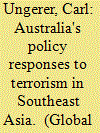

|
|
|
| 5 |
ID:
162653
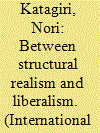

|
|
|
|
|
| Summary/Abstract |
In this article, I argue that Japan's threat perception has evolved in response to the balance of power and perceived intent. Russia, North Korea, and China are all nuclear powers with sizable conventional forces, but the level of threat varies over time, with Japan's response pattern changing from Russia to North Korea to China in recent years. Japan remains a quiet member of the war on terror, but it faces little direct threat from global terrorism and groups like al Qaeda and the Islamic State. Japan's threat response is unique; it skews toward weapons acquisition and enhanced logistics, limiting to a minimum constitutional reform and changes in national security institutions. The well-known antimilitarist norm of the postwar era may be eroding, but it still puts a heavy brake on many “revisionist” projects, including constitutional amendment of Article 9. As a result, Japan's response to the threats has been modest, doing little to prevent China's rise, while growing more dependent on the United States.
|
|
|
|
|
|
|
|
|
|
|
|
|
|
|
|
| 6 |
ID:
117952
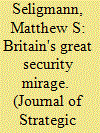

|
|
|
|
|
| Publication |
2012.
|
| Summary/Abstract |
This article focuses on the relationship between the threat perception analyses of the British Admiralty and the strategic orientation of the Royal Navy at the outset of the twentieth century. The current view is that this was an era when fear of France and Russia drove British naval policy. However, as this article will show, Britain's Naval Intelligence Department formed a low opinion of French and Russian naval capabilities at this time and this negative evaluation exerted considerable influence over decision making. The belief that, owing to multiple qualitative deficiencies, these powers could definitely be beaten in battle lessened the standing of the Franco-Russian naval challenge and freed the Admiralty to consider the danger posed by other possible enemies, most notably Germany.
|
|
|
|
|
|
|
|
|
|
|
|
|
|
|
|
| 7 |
ID:
144659


|
|
|
|
|
| Summary/Abstract |
Japan and South Korea have had differing patterns of responding to China’s rise and
aligning with the United States. This can be explained by shifting threat perceptions
based on interactions between evolving systemic and local threats, from both China
and North Korea, as well as their relative degrees of imminence.
|
|
|
|
|
|
|
|
|
|
|
|
|
|
|
|
| 8 |
ID:
179527
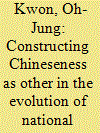

|
|
|
|
|
| Summary/Abstract |
This study traces the way the evolving nature of the Korean national identity has shaped the construction of the Chineseness of immigrants as others. Two immigrant groups, Chinese immigrants called Hwagyo and Korean-Chinese referred to as Joseonjok, have constituted the majority of foreigners in Korea during different historical eras. Although Koreans assumed both represented ‘Chinese’ people, I argue that the core of their Chineseness was defined differently according to the evolving sense of the Korean subjectivity. The growth of the national economy and the culturally advanced and orderly society constituted the sources of the national character and provided legitimate grounds to discriminate against Chinese immigrants who were assumed to pose economic and cultural threats. This study suggests that the different logic of ‘othering’ is derived from the evolution of the Korean national identity in response to the nation’s changing economic and political circumstances.
|
|
|
|
|
|
|
|
|
|
|
|
|
|
|
|
| 9 |
ID:
092261
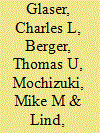

|
|
|
|
|
| Publication |
2009.
|
| Summary/Abstract |
How can Japan put its past behind? Scholars, journalists, and activists frequently argue that Japan cannot solve its "history problem" unless it follows West Germany's lead in offering contrition for World War II violence. Into this debate, Jennifer Lind's Sorry States: Apologies in International Politics offers an original and provocative contribution. Lind argues that while countries should acknowledge past atrocities, frequent public apologies can be domestically polarizing and diplomatically counterproductive. Sorry States outlines a theory of remembrance and threat perception and tests it in a comparative study of Japanese-South Korean and Franco-German relations after World War II. Its methods, data, and findings will interest not only East Asianists, but also scholars of international reconciliation and security studies more broadly. This roundtable presents three critical essays in addition to a response by the author. They discuss the mechanisms through which historical memory influences perceptions of threat, the relative weight of ideational versus material factors in threat perception, and whether changes in international norms and economic interdependence may increasingly pressure countries to confront past violence.
|
|
|
|
|
|
|
|
|
|
|
|
|
|
|
|
| 10 |
ID:
185652


|
|
|
|
|
| Summary/Abstract |
As Asia’s largest and most rapidly rising powers in contemporary global politics, relations between India and China are becoming evermore intertwined with each other. Clear commonalities typify this symbiosis, including a shared civilisational basis, a mutual desire to rebecome great powers in international relations and common modernisation goals. At the same time, relations are beset by a number of issues, most notably long-standing territorial disputes, frictions over regional hegemony and wider diplomatic tensions (most prominently relating to China–Pakistan and India–United States ties). As such, India–China relations can be considered to resemble a ‘double-edged sword’, whereby elements of their interaction can be regarded as having concurrent benefits and liabilities. This article explores the historical roots and contemporary realisation of such a core dynamic over the last 75 years of relations between New Delhi and Beijing and investigates how their strategic goals are often simultaneously convergent and divergent.
|
|
|
|
|
|
|
|
|
|
|
|
|
|
|
|
| 11 |
ID:
066287
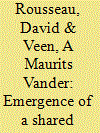

|
|
|
| 12 |
ID:
151441


|
|
|
|
|
| Summary/Abstract |
How to understand and explain the evolutions as well as predict the future directions of bilateral relations between the United States and China has become an imperative task for both policy makers and academic scholars. Borrowing insights from neoclassical realism, this paper suggests a three-stage, perceptual model of ‘threat–interest’ to explore the dynamics of Sino–US relations from 1949 to 2015. It argues that the nature of US–China relations, either cooperation or competition, is mainly shaped by the perceptions of leaders regarding security threats and economic interests between the two nations. How to manage their perceptions regarding each other and how to find a balance between cooperation and competition are the key issues for leaders in both the United States and China to manage bilateral relations in the future. The next decade or two may be the best or the worst times for US–China relations.
|
|
|
|
|
|
|
|
|
|
|
|
|
|
|
|
| 13 |
ID:
156655
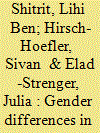

|
|
|
|
|
| Summary/Abstract |
The relationship between gender and political aggression is hotly debated and the empirical evidence is often mixed. While many surveys find a gender gap, with women less supportive of politically motivated aggression and violence than men, numerous case studies point to women’s active involvement in political violence and refute the association of women with peacefulness. This article argues that the gender–aggression relation depends upon (1) the type of political aggression under study (i.e. direct vs. indirect political aggression), and (2) contextual factors, notably the salience of a protracted conflict. Using original datasets representing Israeli Jews (N = 3,126) we found that in the context of protracted conflict, gender has a unique effect on support for indirect forms of political aggression, over and above other central predictors of political aggression (i.e. political orientation and threat perceptions), such that women are actually more supportive of politically motivated social distancing and exclusion of out-groups in conflict as compared to men. Women and men, however, do not differ in their support for direct, politically motivated, violent acts against government officials. Results also shed light on potential mechanisms underlying these differences (and lack thereof), in the context of protracted conflict. The findings cast further doubt on the stereotype of ‘peaceful women’ and point to the need for policymakers concerned with conflict resolution to address context-related factors when considering the gender-based differences in political aggression.
|
|
|
|
|
|
|
|
|
|
|
|
|
|
|
|
| 14 |
ID:
119234
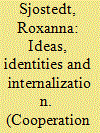

|
|
|
|
|
| Publication |
2013.
|
| Summary/Abstract |
Why do some events take precedence over others in terms of being viewed as security issues? This article argues that in order to answer this question it is necessary to move beyond the assumption that threat images are self-evident. Rather, a distinction should be made between the contextual conditions that may lay the foundation for a threat image and the subjective problem formulation by actors. In addition, in order to analyze how, why, and when an actor constructs a threat image and initiates a so-called securitization process, a broad conceptual and analytical framework should be employed. This article suggests a framework that incorporates ideas and identity at the international and domestic levels, and the internalization processes of the central decision-making unit performing the securitization. The article argues that while the diffusion of ideas by entrepreneurs forms an important basis for the threat constructions of national decision-makers, it is necessary to take the role of national and domestic identities into account in order to explain why some idea diffusion processes succeed while other do not. Identity serves as a catalyst or gate-keeper of idea diffusion. The internalization of the decision-making unit, finally, is a central mechanism that highlights the process between the explanatory factors and the outcome (securitization). By including these three concepts into the analysis, this article takes a holistic approach that can be employed to analyze different kinds of actor-based and non-actor-based threat images.
|
|
|
|
|
|
|
|
|
|
|
|
|
|
|
|
| 15 |
ID:
151439
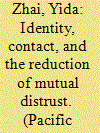

|
|
|
|
|
| Summary/Abstract |
In the midst of rising tension between China and Japan, two powerful countries in Asia, the favorable attitudes of each country's citizens toward the other country have dropped to a historical low. The Taiwan issue, historical legacy, island disputes, and maritime resource competition are major obstacles in Sino-Japanese relations, but the most fundamental issue is a deep-seated mutual distrust and suspicion between the two countries, which result in rising threat perceptions. Beyond the structural and political elite-centered approaches, this study examines the evidence related to the three approaches (face-to-face contact, cross-cultural exposure, and social identity) to reduce mutual distrust and antipathy in the two countries. With a careful analysis of the survey data, this study sheds light on the conditions under which contact (a) results in improved attitudes toward outgroup, (b) has little or no effect on intergroup relations, and (c) yields more prejudice and hostility toward the outgroup. The findings of this study not only identify factors that could facilitate mutual understanding between Chinese and Japanese people and more favorable impressions of one another, but are also relevant to planning interventions to reduce prejudice and distrust among people from different races, religions, and countries.
|
|
|
|
|
|
|
|
|
|
|
|
|
|
|
|
| 16 |
ID:
137167


|
|
|
|
|
| Summary/Abstract |
The narrative of an aggressive and neo-imperialist Russia that has dominated analyses of the 2014 Ukrainian crisis lacks theoretical rigour. We argue that a sustainable transformation of the Ukrainian crisis requires an accurate analysis of the context of the conflict, which should include an understanding of Moscow’s perception of the threats to its interests. This policy brief develops a theoretical understanding of the Ukrainian crisis through the lens of Stephen M. Walt’s balance of threat theory. We conclude that a realist analysis will help to explain Russian actions.
|
|
|
|
|
|
|
|
|
|
|
|
|
|
|
|
| 17 |
ID:
193164


|
|
|
|
|
| Summary/Abstract |
The Apartheid-era South African military (SADF) underwent dramatic peacetime changes, from a small and underfunded expeditionary element of Commonwealth forces in the 1950s to a regime bulwark with regional capabilities under ‘Total Strategy’ in the mid-1970s. By comparing internal assessments, changes in the SADF’s official view of future wars are traced through security crises of the 1960s and 1970s. Shifting future war perceptions were shaped by the interplay of organizational-political needs during crises of legitimacy for the military. These shifts in future war perception motivated strategic and operational-tactical doctrinal change and shaped the military’s view of security crises.
|
|
|
|
|
|
|
|
|
|
|
|
|
|
|
|
| 18 |
ID:
142344
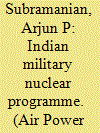

|
|
|
| 19 |
ID:
174857
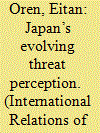

|
|
|
|
|
| Summary/Abstract |
Scholars have recently commented on Japan’s increasing threat perception, either in the context of an ‘increasingly complex security environment’, or in the context of its use by Japanese elites to advance their political goals. Yet, while references to Japan’s threat perception are ubiquitous, conceptual clarity and comprehensive empirical evidence are far less so. This article seeks to address these gaps by conducting a longitudinal study of threat perception in postwar Japan. Data are driven from content analysis of debates in Japan’s national parliament over a period of seven decades (1946–2017). The evolution of Japan’s threat perception is analyzed, and a revisionist account of Japan’s threat perception is put forward. Thus, this study serves both as a metric of threat perception in postwar Japan and as a model for the study of threat perception in international relations.
|
|
|
|
|
|
|
|
|
|
|
|
|
|
|
|
| 20 |
ID:
186807


|
|
|
|
|
| Summary/Abstract |
Although only 23 people on average have been killed per year by terrorist attacks in the United States since 2001, American citizens and politicians consistently rank terrorism as a top security threat, leading to costly wars abroad and the repression of civil liberties at home. To what extent can education about terrorism alter perceptions of the threat? Much existing scholarship—and consistent polling over the past two decades—suggests that it cannot, but we disagree. Evidence gathered from an extensive series of experimental and observational surveys involving students in 31 terrorism and non-terrorism related courses at 12 universities—including massive open online courses (MOOC) and online surveys—reveals that the more individuals learn about terrorism, the smaller they perceive the threat to be to themselves and to the U.S. In the fight against terrorism and the fear it inspires, knowing really is half the battle.
|
|
|
|
|
|
|
|
|
|
|
|
|
|
|
|
|
|
|
|
|